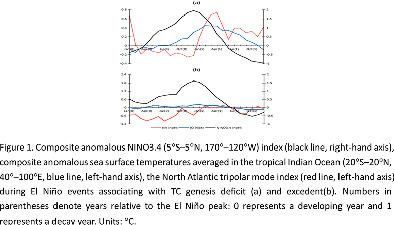当前位置:
X-MOL 学术
›
Q. J. R. Meteorol. Soc.
›
论文详情
Our official English website, www.x-mol.net, welcomes your
feedback! (Note: you will need to create a separate account there.)
Tropical cyclone genesis over the western North Pacific impacted by SST anomalies from other basins while El Niño decays
Quarterly Journal of the Royal Meteorological Society ( IF 3.0 ) Pub Date : 2021-04-11 , DOI: 10.1002/qj.4042 Jin‐Hua Yu 1 , Lijian Ou 1 , Lin Chen 1 , Laurent Li 2 , Ming Sun 1 , Xiaoyao Zhong 1 , Xuyu Zhang 1
Quarterly Journal of the Royal Meteorological Society ( IF 3.0 ) Pub Date : 2021-04-11 , DOI: 10.1002/qj.4042 Jin‐Hua Yu 1 , Lijian Ou 1 , Lin Chen 1 , Laurent Li 2 , Ming Sun 1 , Xiaoyao Zhong 1 , Xuyu Zhang 1
Affiliation

|
Tropical cyclone (TC) genesis over the western North Pacific (WNP) in the TC active season July–October after El Niño peaks in the preceding December is revealed to be either deficient or excessive, depending on how El Niño is able to remotely create and maintain sea-surface temperature (SST) anomalies in the North Atlantic and Indian Ocean during spring while El Niño decays. A reduction of TC genesis (Group 1) is coincident with a warming in the Indian Ocean and a positive tripolar SST pattern in the North Atlantic, while enhanced TC genesis (Group 2) corresponds to the configuration without significant SST anomalies in the North Atlantic and in the Indian Ocean. Relevant physical mechanisms are investigated through observational data analysis and confirmed with model simulations. In Group 1, El Niño SST anomalies enhance convection over the central-eastern equatorial Pacific. The related latent heat release excites Rossby wave trains which can efficiently propagate energy from the eastern tropical Pacific into Central America and further into the subtropical North Atlantic. The warm SST anomalies found in the Indian Ocean and in the North Atlantic can force robust anomalous easterlies in the tropical WNP, producing unfavourable dynamic and thermodynamic conditions for TC genesis. Group 2 shows a quite distinct situation. Actually, the late winter anomalous westerlies are much weaker over Central America in Group 2, providing a configuration of inhibition for an efficient wave energy propagation from the tropics into the subtropical North Atlantic. The warm SST over the Maritime Continent is then responsible for the increase of TC genesis over the South China Sea and around the Philippines by exciting a cyclonic circulation in the TC active season.
中文翻译:

受其他盆地海温异常影响而厄尔尼诺现象衰减的西北太平洋热带气旋成因
在去年 12 月的厄尔尼诺现象达到顶峰之后,7 月至 10 月的 TC 活动季中北太平洋西部 (WNP) 上的热带气旋 (TC) 的形成要么不足要么过度,这取决于厄尔尼诺现象如何能够远程产生和在厄尔尼诺现象衰减的同时,在春季维持北大西洋和印度洋的海面温度 (SST) 异常。TC 生成减少(第 1 组)与印度洋变暖和北大西洋三极海温呈正模式同时发生,而 TC 生成增强(第 2 组)对应于北大西洋和北大西洋没有明显海温异常的配置。在印度洋。通过观测数据分析研究了相关的物理机制,并通过模型模拟进行了确认。在第 1 组中,厄尔尼诺海温异常增强了赤道中东部太平洋上空的对流。相关的潜热释放激发了罗斯比波列,该波列可以有效地将能量从热带太平洋东部传播到中美洲,并进一步传播到亚热带北大西洋。在印度洋和北大西洋发现的暖海温异常可以迫使热带西北部出现强烈的异常东风,为 TC 的成因产生不利的动力和热力学条件。第 2 组显示了非常不同的情况。实际上,第 2 组中美洲的晚冬异常西风要弱得多,这为从热带到亚热带北大西洋的有效波能传播提供了抑制配置。
更新日期:2021-06-03
中文翻译:

受其他盆地海温异常影响而厄尔尼诺现象衰减的西北太平洋热带气旋成因
在去年 12 月的厄尔尼诺现象达到顶峰之后,7 月至 10 月的 TC 活动季中北太平洋西部 (WNP) 上的热带气旋 (TC) 的形成要么不足要么过度,这取决于厄尔尼诺现象如何能够远程产生和在厄尔尼诺现象衰减的同时,在春季维持北大西洋和印度洋的海面温度 (SST) 异常。TC 生成减少(第 1 组)与印度洋变暖和北大西洋三极海温呈正模式同时发生,而 TC 生成增强(第 2 组)对应于北大西洋和北大西洋没有明显海温异常的配置。在印度洋。通过观测数据分析研究了相关的物理机制,并通过模型模拟进行了确认。在第 1 组中,厄尔尼诺海温异常增强了赤道中东部太平洋上空的对流。相关的潜热释放激发了罗斯比波列,该波列可以有效地将能量从热带太平洋东部传播到中美洲,并进一步传播到亚热带北大西洋。在印度洋和北大西洋发现的暖海温异常可以迫使热带西北部出现强烈的异常东风,为 TC 的成因产生不利的动力和热力学条件。第 2 组显示了非常不同的情况。实际上,第 2 组中美洲的晚冬异常西风要弱得多,这为从热带到亚热带北大西洋的有效波能传播提供了抑制配置。









































 京公网安备 11010802027423号
京公网安备 11010802027423号